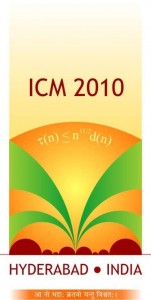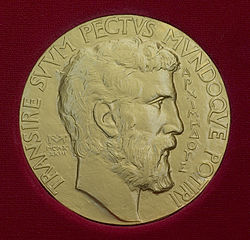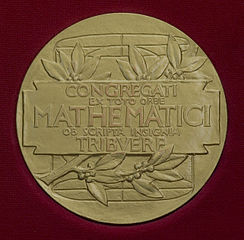Professor Edward Frenkel (http://math.berkeley.edu/~frenkel/) is one of the main scientific organizers for the inaugural Fields Medal Symposium. The main focus of his research is symmetry in mathematics and quantum physics. Many of the questions that he is currently tackling have their origins in the Langlands Program. He is Professor of Mathematics at the University of California, Berkeley.
At this year’s Fields Medal Symposium, Frenkel will be giving a general survey lecture on the Langlands Program, and he will also sit on a panel to talk about the world of mathematical research. Prior to the panel he will be giving another short talk to provide context for the discussion. Frenkel is a strong advocate for improving the public image and understanding of mathematics.
Frenkel has agreed to contribute regularly to our blog. His first post deals with some general questions from Richard Cerezo about the Langlands Program.
Would you characterize the work being done in the Langlands Program as the rigorous development of mathematical language that relates number theory and mathematical analysis?
Yes. And there is also much more to it.
Could you please elaborate?
In creating the Langlands Program, Robert Langlands was motivated, in the late 1960s, primarily by hard questions in number theory.
What kinds of questions?
Let’s say you have an equation such as y^2 = x^3 + 5x +3 and you look for solutions x, y that are not real or complex numbers, but elements of the finite field Z/pZ, where p is a prime number. In other words, you look for x and y from the set of integers {0,1,2,…,p-1} such that when you substitute them into the equation, the left hand side is equal to the right hand side up to a multiple of p — we then say that the equations is satisfied “modulo p”. For instance, let p=5, and take x=1, y=2. Then the left hand side is equal to 4, and the right hand side is equal to 9. The difference is 5. So x=1,y=2 is a solution “modulo 5”.
There are plenty of equations of this kind in number theory. And we want to know, for example, how many solutions a given equation has modulo p, for all possible primes p. This turns out to be a very hard question.
Langlands’ deep and surprising insight was that these mysterious numbers of solutions could be read off objects of an entirely different world, called “harmonic analysis”.
What is harmonic analysis?
It is the study of functions of a particular kind. For instance, we all know trigonometric functions (of a variable x), sin(x) and cos(x). Let us consider also sin(nx) and cos(nx) for all integers n. The idea, going back to Fourier in the 19th century, is that almost all functions that are periodic can be written as superpositions of these very basic functions. This is a remarkable statement! Imagine that we have a signal that is represented by a function. Writing it as the sum of trigonometric functions represents the decomposition of the signal into “elementary harmonics”. This is what harmonic analysis is about: funding some elementary harmonics, like sin(nx) and cos(nx), but in a much more general situation, and finding ways to decompose general functions in terms of these harmonics.
This is a beautiful theory, and note that from the outset it seems to be very far away from number theory.
Here comes a surprise: Langlands conjectured that these two worlds: number theory and harmonic analysis, are inextricably linked. More precisely, he conjectured that the questions in number theory like finding numbers of solutions of equations modulo primes can be solved by harmonic analysis. For example, there is a harmonic function that “knows” about the numbers of
solutions of the above equation modulo all primes (or maybe all but finitely many primes, but that’s a technical point).
This is absolutely mind-boggling, kind of black magic! And that’s why people got so excited about the Langlands Program: first of all, because it gives us a way to solve what look like intractable problems. And second, because it points to some deep and fundamental connections between different areas of mathematics. So we want to know what is really going on here, why it is like this? And we still don’t fully understand it.
So these are the origins of the Langlands Program. But then what happened is that people realized that the same mysterious patterns may be observed in other areas of mathematics, such as geometry, and even in quantum physics. I have previously written, partly tongue-in-cheek, that the Langlands Program is a Grand Unified Theory of Mathematics. What I meant by this is that the Langlands Program points to some universal phenomena and connections between these phenomena across different fields of mathematics. And I believe that it holds the keys to understanding what mathematics is really about.
Can you talk further about the idea that the Langlands Program might serve as mathematics’ Grand Unified Theory?
The Langlands Program is a vast subject. Hence there is a large community of people. But, as I said, the ideas of the Langlands Program have penetrated into many areas of mathematics. So you have people working in number theory, or in harmonic analysis, or in geometry, or in mathematical physics, working with very different objects, but observing similar phenomena. What’s most interesting to me is to see how the same patterns play out in all of those different domains and understanding how these different areas are connected.
It’s like you have different languages and you have sentences from those different languages which you know mean the same thing. You put them next to each other and little by little you start developing a dictionary that allows you to translate between different areas of mathematics.
In other words, I view the Langlands Program not as an “area” of mathematics, but as a “meta-area”, in the sense that it is something that is observed throughout mathematics.
Is there a way to look at the Geometric Langlands Program (GLP) informally or intuitively? If so, and if possible, could you please give us your everyday version of the GLP?
I have tried to give above a “pedestrian” version of the Langlands Program, the way it was originally formulated.
When people say “geometric Langlands Program”, they mean a set of similar ideas playing out in geometry. In geometry, instead of the algebraic equations modulo primes that I talked about earlier, we have objects that at first glance look very different: namely, the so-called Riemann surfaces. The simplest one is the sphere, then we have the surface of the donut (with one “hole”, so to speak), then there is the surface of a Danish pastry (with two “holes”), and so on. Why these geometric objects are analogous to the equations modulo primes requires a separate explanation, which I won’t give you. Let’s just say that this is something that mathematicians have known and exploited for a long time and let’s trust that there is this analogy.
So then the natural question is: what should be the objects on the other side, what are the analogues of harmonic functions? This is by no means obvious, and this was understood much later, in the 1980s, in the works of several great mathematicians: Deligne, Drinfeld, Laumon, Beilinson, and others.
Roughly speaking, the objects on the other side may be expressed in terms of what we call “D-modules”. D-modules are, roughly speaking, mathematical objects representing systems of partial differential equations. So now the surprising link discovered originally by Langlands between number theory and harmonic analysis becomes a link between some objects related to Riemann surfaces and D-modules. This link is as fascinating as the original Langlands conjectures.
At other conferences similar to the Fields Medal Symposium, was work on the proof of the Fundamental Lemma the centre of attention? Did you or any of your collaborators take a shot at proving that particular result?
Let me say a few words about the Fundamental Lemma. In pursuing his Program, Langlands came up with certain mathematical formulas that should hold for his Program to work. He called the statement that these formulas are true “the Fundamental Lemma”. Why did he call it a lemma, and not a theorem? I guess he thought that this was a rather technical statement that one could prove in a fairly straightforward way. Well, unfortunately, that was not the case. This “lemma” resisted attempts by many mathematicians to prove, until finally Ngo Bao Chau came up with a brilliant proof. His proof uses entirely new geometric ideas (some of which were introduced earlier by Goresky, Kottwitz, and MacPherson, as well as Laumon — partially, in collaboration with Ngo himself).
Of course, everybody knew that the Fundamental Lemma was one of the central statements of the Langlands Program. People worked on it and there were meetings and conferences at which the subject was discussed. But there is something that you have to understand. The Fundamental Lemma is a statement in the “original” Langlands Program; more precisely, it is a statement in harmonic analysis. So people working in the geometric Langlands Program, like myself, did not pay much attention to it. But a remarkable aspect of Ngo’s proof is that it is geometric — and moreover, it uses many of the objects that are the staples, so to speak, of the geometric Langlands Program. So what Ngo’s work has done (in addition to proving a very important and long-standing result) is that it brought together people from different fields.
The program of our Fields Symposium is a testimony to this: we will have lectures by the top experts across different disciplines: number theory, harmonic analysis, geometry, and physics. This is what Ngo’s work has done. And this is very important in my view.
There seem to be a number of very distinguished people working inside the Langlands Program and it has a good amount of well-deserved attention. Could you please give us your reasons for continuing to work in this Program?
The more we know, the more we understand how little we know. As I said, the beauty of the Langlands Program is that it points to mysterious connections between different fields of mathematics. And the biggest question, in my mind, is why these connections exist, what is the mechanism behind them. We still don’t know, but we are working on it. For example, in my recent joint work with Langlands and Ngo, we suggested a path to proving the so-called Arthur–Selberg trace formula using methods similar to those used by Ngo, as well as ideas from the geometric Langlands Program. Ngo’s work has matured us. We now understand better how different pieces of the puzzle fit together. But we need new, fresh ideas. I hope that young people who come to our Symposium, who follow it online, will get interested in this subject and will lead the next revolution in the Langlands Program.





